What is Calcific Tendinopathy?
Calcific cuff tendinopathy is a problem with the shoulder’s tendons and muscles. This condition occurs due to the formation of calcium deposits in the tendons (tissue which attaches muscle to bone) of the rotator cuff (group of muscles and tendons stabilising the shoulder). This calcium build-up causes inflammation of the tissues surrounding it, and intense shoulder pain. The space between the rotator cuff and the acromion (outer bony end of the shoulder blade) is also reduced due to the calcium deposits, affecting the normal functioning of the rotator cuff.
The deposits often occur in people above 30-40 years old and are more common in diabetic patients.
Symptoms of Calcific Tendinopathy
During the process of calcium deposition, you may either experience no pain at all or mild to moderate pain. You may experience pain while lifting your arm or loss of motion in the shoulder due to stiffness. Severe pain may also interfere with your sleep.
These symptoms are characteristic to three stages through which calcific cuff tendinopathy progresses.
- Pre-calcification stage: This is the beginning of calcium formation where changes happen in the cells and you may not experience any symptoms.
- Calcific stage: The cells release calcium, which combines to form calcium deposits. This stage generally lasts for a varied period of time without any pain and is called resting phase. The most painful phase called resorptive phase begins after the resting phase. Most patients seek treatment during this phase due to the severe pain associated with this stage.
- Post-calcific stage: The calcium deposition starts being replaced with normal rotator cuff tendon. This stage is usually painless.
Causes of Calcific Tendinopathy
The exact cause of calcific cuff tendinopathy is unknown. It is believed that aging, increased pressure on the tendons and/or severe wear-and-tear may be responsible for calcification. Inadequate oxygen in the tendons may also cause calcium deposition.
Diagnosis Calcific Tendinopathy
Calcific cuff tendinopathy is diagnosed by thorough physical examination of the shoulder and a detailed medical history carried out by your doctor. X-rays can be ordered to detect calcific deposits. The deposits not seen on X-rays can be viewed with an ultrasound scan which allows assessing the size of the deposits from all directions.
Treatment for Calcific Tendinopathy
The calcific cuff tendinopathy generally resolves on its own without the need for surgery. Certain conservative treatment measures may be recommended by your physician.
Nonsurgical Approach for Calcific Tendinopathy
The nonsurgical approach is the first line of therapy for calcific tendonitis.
- Anti-Inflammatory medications: The pain associated with calcific deposits can be treated with anti-inflammatory medications.
- Steroid injections: If you experience severe pain, steroid injections may be administered to relieve pain, swelling and inflammation.
- Heat/ice application: A wash cloth dipped in warm or ice water can be placed on the affected shoulder to relieve pain.
Surgical Treatment for Calcific Tendinopathy
Surgery is suggested only if your daily life is affected with persisting pain and loss of movement and conservative methods are unsuccessful. The surgeries are outpatient procedures performed under general anaesthesia.
- Arthroscopic surgery: Your surgeon will make a small incision and insert an arthroscope (lighted camera) into the shoulder joint. Calcium deposits will be located in the rotator cuff tendon using the arthroscope, then the deposits are removed with tiny surgical tools and the area is rinsed with saline solution.
- Open surgery: In very rare cases, your surgeon will cut through the skin, muscles and the surrounding tissues to remove the calcium deposits. The area will be rinsed to remove the remaining calcium crystals. The muscles and skin will then be stitched together to close the incision.
Postoperative Rehabilitation for Calcific Tendinopathy
Rehabilitation is required to strengthen the rotator cuff muscles and stabilise the shoulder joint. After surgery, you will be asked to support your shoulder in a sling. Your therapist may recommend ice, electrical stimulation and massage therapy to control pain, swelling and ease muscle spasms during the initial few sessions of rehabilitation.
Range of motion exercises and active stretching may be recommended after arthroscopic surgery. You will have to start with passive exercises, like gently moving your shoulder joint and stretching your arm, and then progress to active exercises. You will be taught many ways you can perform daily tasks without exerting much pressure on your shoulder, in an attempt to get you back to a normal lifestyle.

